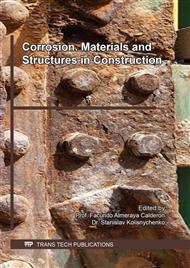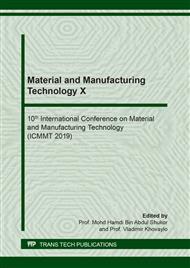[1]
Hans Bohni, Corrosion in reinforced concrete structures,. CRC Press, Woodhead Publishing Limited, Cambridge, England, (2005).
Google Scholar
[2]
Ahmad, S., Reinforcement corrosion in concrete structures, its monitoring and service life prediction,, Cement and Concrete Composites, 25, (2003), pp.459-471.
DOI: 10.1016/s0958-9465(02)00086-0
Google Scholar
[3]
Broomfield, J.G., Corrosion of steel in concrete: understanding, repair and investigation,, First Edition, E and FN Spon, UK, (1997).
Google Scholar
[4]
Antonio Costa and Julio Appleton. Case studies of concrete deterioration in a marine environment in Portugal,. Cement and concrete composites, 24, (2002), pp.169-179.
DOI: 10.1016/s0958-9465(01)00037-3
Google Scholar
[5]
M. Sosa, T. Pérez-López, J. Reyes, F. Corvo , R. Camacho-Chab, P. Quintana , D. Aguilar. Influence of the Marine Environment on Reinforced Concrete Degradation Depending on Exposure Conditions,. Int. J. Electrochem. Sci., 6 (2011), p.6300 – 6318.
Google Scholar
[6]
Erhan Güneyisi, Mehmet Gesoğlu, Fatih Karaboğa, Kasım Mermerdaş. Corrosion behavior of reinforcing steel embedded in chloride contaminated concretes with and without meta kaolin,. Department of Civil Engineering, Gaziantep University, Turkey. April (2012).
DOI: 10.1016/j.compositesb.2012.09.085
Google Scholar
[7]
T.A. Soylev, R.Francois. Quality of Steel – concrete interface and corrosion of reinforcing steel", science direct,, 12, November, (2002).
Google Scholar
[8]
S. Subasi, M.Arslan and G.Durmus. The Effects of Various from Work Surfaces on the Corrosion Performance of Reinforcing Steel in Concrete,, Materials and Corrosion , (2010).
DOI: 10.1002/maco.200905236
Google Scholar
[9]
B. Pradhan, B .Bhattacharjee The Performance of Rebar in Chloride Contaminated Concrete by Corrosion Rate, Department of Civil Engineering, India.(2008).
Google Scholar
[10]
Rakshita Nagayac.The water cement ratio associated with the strength of concrete,, Quora (June 2015).https://www.quora.com/How is the water cement ratio associate with the strength of concrete.
Google Scholar
[11]
John P.Broomfield.Corrosion Of Steel In Concrete,, 2nd Edition, Taylor & Francis, London, (2007).
Google Scholar
[12]
A. Taher, G. Jarjoura and G. J. Kipouros, The Effect of Sulphate on the Electrochemical Behaviour of a Cu-Ni-Fe alloy (C70600),, J. of Corr. Sci. and Eng., 12, (2010), pp.42-42.
DOI: 10.1149/ma2007-01/11/512
Google Scholar
[13]
AbdAlrahim Al Shikshak, AbdAlhakem Mansour, A. Taher, Effect of Flow Velocity of Sea Water on Corrosion rate of Low Carbon Steel,, Applied Mechanics & Materials, Vol.799-800, (2015), pp.232-236.
DOI: 10.4028/www.scientific.net/amm.799-800.232
Google Scholar



